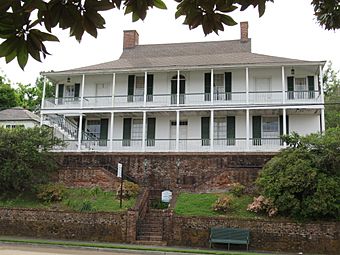House on Ellicott's Hill facts for kids
|
House on Ellicott's Hill
|
|

House on Ellicott's Hill in 2019
|
|
| Location | 215 Canal Street N, Natchez, Mississippi |
|---|---|
| Built | 1798 |
| Architect | James Moore |
| NRHP reference No. | 74001050 |
Quick facts for kids Significant dates |
|
| Added to NRHP | May 30, 1974 |
| Designated NHL | May 30, 1974 |
The House on Ellicott's Hill, also called Connelly's Tavern or the James Moore House, is a very old and important house in Natchez, Mississippi. It was built in 1798. This makes it the oldest building still standing in Natchez from when it was a new territory. Today, it is a historic house museum where people can visit and learn about the past. In 1974, it was named a National Historic Landmark. Later, in 2001, it became a Mississippi Landmark.
Contents
History of the House
The House on Ellicott's Hill is a special building. It shows how houses were built in the Lower Mississippi Valley a long time ago. It was constructed between 1798 and 1801. This house was also one of the first buildings in the Mississippi Territory to show the style called "Federal style."
Unique Design and Materials
The house has a unique roof shape. It has smaller roofs attached high up on a central pointed roof. This style was common in Anglo-American areas. It was different from French Louisiana houses, which often had central flat roofs. The house also used a special material called bousillage for its upper walls. This material is a mix of mud and Spanish moss.
The house was built into the side of a hill. This means it looks like a two-story building from the front. The front has a raised brick basement. But from the back, it looks like a single-story house. A special ditch at the back helps bring light and air into the basement rooms.
Early Descriptions of Natchez Homes
In 1805, a woman named Eliza Baker wrote a letter home. She described houses in Natchez that were similar to the House on Ellicott's Hill. She mentioned houses with two stories in front and one in the back. They also had long porches, sometimes with blinds.
An English writer, Fortescue Cuming, visited Natchez later. He wrote that Natchez reminded him of towns in the West Indies. He noted that the houses had balconies and porches. This similarity makes sense because Natchez and the West Indies shared similar weather. They also had similar trade connections and cultural influences.
The Hill's Important Past
The land where the house stands was given to James Moore in 1797. He was a merchant in Natchez. Building probably started after January 1798. At that time, American soldiers were camped on the hill. They were there to take control of Spanish areas east of the Mississippi River.
The hill was also where Andrew Ellicott set up his camp. He was sent by President George Washington. His job was to map the border between the new Mississippi Territory and Spain. It is believed that Ellicott was the first to raise the American flag on this hill. The Spanish governor, Gayoso, even aimed his fort's cannons at the flag!
By 1801, James Moore was living in the house. In 1805, the house was valued at $8,000 for tax purposes. This made it one of the most valuable houses in the city. The house has kept most of its original features. This includes the beautiful doorways with fan-shaped windows. These are some of the earliest examples of the Federal style in Mississippi.
Restoring the House
By 1934, the House on Ellicott's Hill was in poor condition. The Natchez Garden Club bought it to save it. They worked with an architect named Richard Koch to restore the house. They fixed the brickwork, repaired wood and plaster, and restored the wood trim.
A Case of Mistaken Identity
When the restoration began, people thought the house used to be a tavern. They believed it was owned by Patrick Connelly. However, later research by the Natchez Garden Club found out the real tavern was on a different street. It was actually one block southeast of the House on Ellicott's Hill.
Most of the changes to the house happened during this 1930s restoration. For example, the design of the porch staircase was changed. The Natchez Garden Club's restoration was very important. It was the first time an organization in Mississippi bought and restored a historic building.
Today, the House on Ellicott's Hill is open to the public. It is a house museum run by the Natchez Garden Club. Visitors can explore the house and learn about its long history.
See also



